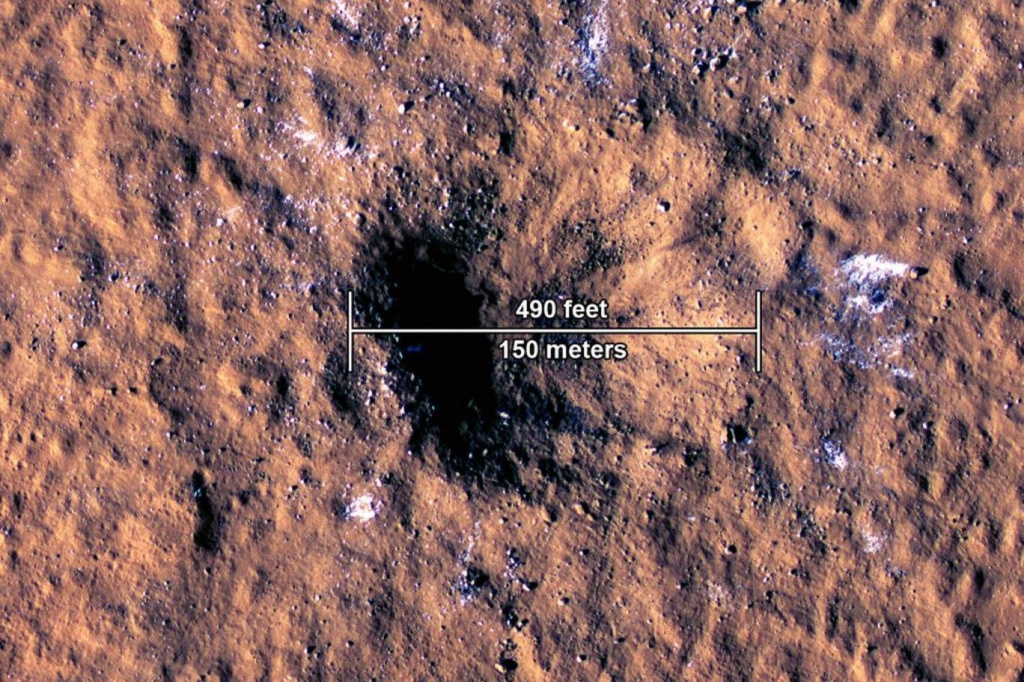A precious gift from Mars... the sound of a meteor impact
The "Insight" probe detected enough impact force to simultaneously generate large waves, allowing a detailed study of the internal structure of the Red Planet

An image distributed by NASA of the crater left by the meteorite (AFP)
Scientists observing Mars received a precious gift on Christmas Eve last year... On December 24, 2021, a meteor smashed into the surface of the Red Planet, causing tremors of magnitude four.
It was possible to monitor these tremors directly by the probe " Insight " located in the space site.
These tremors were detected by the seismometer of the "InSight" probe, which landed on the surface of Mars about four years ago, about 3,500 km from the impact site.
But the origin of this Martian earthquake was only known later, thanks to the Mars Reconnaissance Orbiter (or MRO) spacecraft, which was in orbit of the planet and took pictures of the newly formed crater within the 24 hours after the impact.

The InSight probe during its mission to Mars (AP)
blocks of ice
This stunning image showed masses of ice that were scattered by the impact on the surface, and showed a hole about 150 meters in diameter and 20 meters deep, which is the largest hole that the MRO has ever observed since it entered service 16 years ago.
"We never expected to see something of this magnitude," Ingrid Dubart, who is concerned with the "Insight" and "MRO" missions, said at a press conference Thursday, although meteorites hitting Mars are common and not rare.
The researchers estimated the size of the meteorite itself at about 12 meters, which would have led, if it was heading towards planet Earth, to its disintegration while it is still in the atmosphere.
"Quite simply, the largest meteor impact on the surface that has been heard since the scientific use of seismometers began," said Philippe Leuninet, a professor of planetary science who participated in two studies on the results of monitoring this impact, which were published Thursday in the journal "Science."
Audio recording
And the US space agency (NASA) broadcast an audio recording of the earthquake that was prepared by accelerating the vibrations collected by the seismometer, with the aim of making them audible.
The valuable information provided by this impact should allow for better knowledge of the Martian interior and the formation history of the planet.
And Ingrid Dubar, who participated in preparing the two studies, noted that the presence of ice in particular is "surprising", explaining that "the site where the ice was observed is the hottest on Mars, and it is closest to the equator."
In addition to the scientific contribution of this discovery to the study of the Martian climate, the presence of water at this site could be "very useful" for future explorers, according to what the director of planetary sciences at NASA Laurie Glaes said.
"We would like to land the astronauts as close to the equator as possible," she said.
The force of the meteor impact was sufficient to simultaneously generate large waves (reaching the core of the planet) and surface waves (crossing the planet's crust horizontally), which allowed a detailed study of the internal structure of Mars.
It turns out that the crust on which the probe "InSight" is stationed is less dense than the one that was traversed from the impact site.
Philippe Legnonier of the Institute of Geophysics in Paris considered it also feasible in light of this data to "re-analyze" existing models relating to the "deep structure of the Martian mantle", as Philippe Legnoni explained.
The performance of the InSight probe is currently slow, as expected, due to the dust accumulating on its solar panels.
Bruce Banerdt of NASA's Jet Propulsion Laboratory said Thursday that he is likely to lose contact with him within "about four to eight weeks."
In total, "Insight" monitored more than 1,300 "Martian earthquakes", including those that originated from the impact of smaller meteorites, and scientists around the world will benefit from the data it collected for several years.
Source:websites

